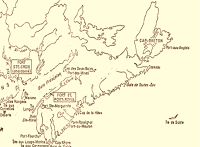
When October and her work week began, there were other things that the University Archivist should have been doing, but as if it was a seductive mystery story, the book into which she plunged was The Description and Natural History of the Coasts of North America. Written by fisherman/explorer Nicolas Denys and originally published in 1672 as Description geographique et historique des costes de l'Amerique septentrionale: Avec l'histoire naturelle du pa?s, it covered the years 1632 through 1670. She was reading the profusely annotated 1908 English translation by William Ganong.
Earlier accounts of Acadia were nowhere near as rich in the details of flora and fauna. Although at times clouded by the writer's territorial invasive hunter/fisherman viewpoint, Nicolas Denys' writing was clear and observant, particularly in contrast to the lofty "This is the Forest Primeval" of Longfellow's "Evangeline", where the University Archivist had fruitlessly sought to verify the presence of Moose in Acadia.
In the over a hundred years that elapsed since the late 15th century or early 16th century period of the Music Box Book of Hours and the mid-17th century publication of Denys' book, the arrival of Europeans had probably somewhat changed the natural environment of Acadia. However, because it was unlikely that Moose had been carried aboard the ships of early fisherman explorers, the finding of Moose in Denys' natural history would be significant.
If she had not been entranced by raspberries and strawberries, rivers thronged with salmon, an abundance of wild walnuts, "quantities of shell-fish of all kinds good to eat", cod, herring, and many instances of beavers, wild geese, doves, pigeons, and ducks, the University Archivist would have already confirmed the presence of Moose in Acadia.




